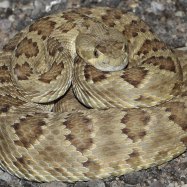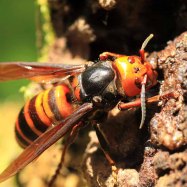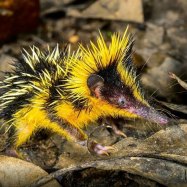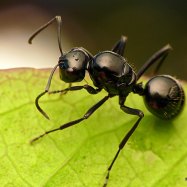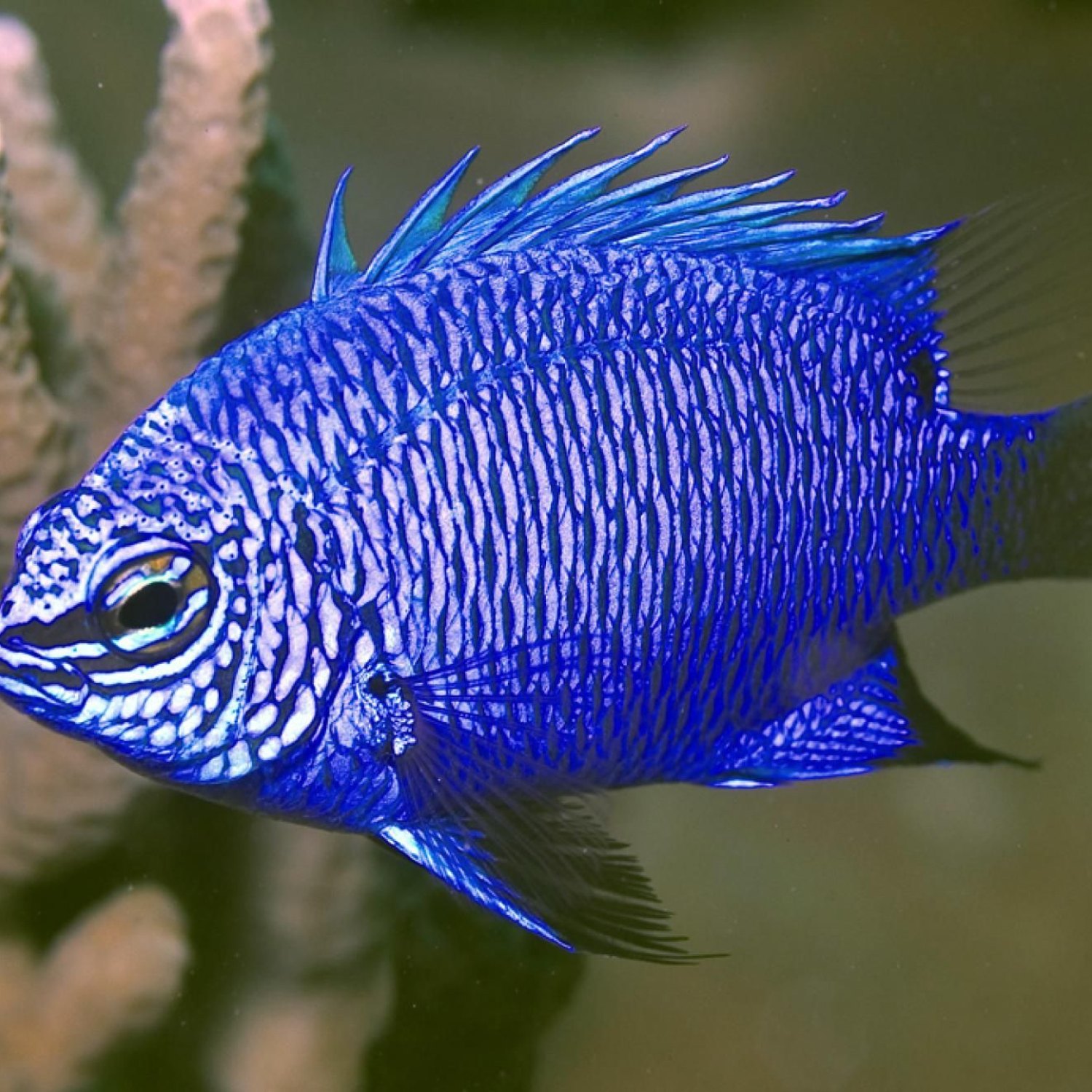
Damselfish
Up to 15 centimeters
Damselfish are colorful and vibrant creatures found in tropical waters around the world. This small and slender fish, belonging to the Pomacentridae family, can grow up to 15cm in length. With its unique body shape and varied locations, it's a popular sight for snorkelers and divers. Explore the beauty of these animals and their fascinating behavior in their natural habitat. #Damselfish #Pomacentridae #TropicalFish #UnderwaterBeauty
Animal Details Summary:
Common Name: Damselfish
Kingdom: Animalia
Habitat: Coral reefs
The Fascinating World of Damselfish
In the vast and diverse underwater world, there is a fish species that often goes overlooked but plays a vital role in maintaining the balance of coral reefs. It is none other than the damselfish, scientifically known as Pomacentridae.These little creatures, with their striking colors and unique behavior, have captured the interest of marine biologists and casual observers alike. In this article, we will take an in-depth look at the damselfish, their characteristics, and why they are a crucial part of the ecosystem Damselfish.
The Classification of Damselfish
Let's start with the basics. Damselfish are a widespread family of small, reef-dwelling fish found in tropical and subtropical oceans around the world. They belong to the kingdom Animalia, phylum Chordata, and class Actinopterygii, making them vertebrate animals with bony skeletons and fins.Damselfish come from the order Perciformes, which includes over 10,000 species of fish. Within this order, they belong to the family Pomacentridae, which consists of more than 400 species of damselfish. This family is further divided into seven subfamilies, each with unique characteristics and behaviors.
The Habitat and Distribution of Damselfish
Damselfish are found in a vast array of habitats, from coastal waters to the open ocean, but they are most commonly associated with coral reefs. Within the reef, they can be found in different zones, from shallow lagoons to the deeper edges of the reef. They tend to stick close to shelter, such as corals or rocks, to protect themselves from predators Dutch Shepherd.These fish are found in tropical and subtropical oceans around the world, including the Indo-Pacific, the Caribbean, and the Red Sea. Their specific distribution depends on the species, with some being limited to certain regions, while others can be found globally.
The Colorful World of Damselfish
One of the first things that stand out about damselfish is their vibrant colors. They are known for their bright hues, like electric blues, brilliant yellows, and fiery oranges. Some species also have contrasting stripes or spots, adding to their visual appeal.But why are they so brightly colored? Some suggest that it is a way for them to attract mates, while others believe it is a form of camouflage to blend in with their surroundings. Whatever the reason, their coloration is undoubtedly a beautiful sight to behold.
The Physical Characteristics of Damselfish
Damselfish are small, typically only growing up to 15 centimeters in length. They have a slender body shape, which is excellent for maneuvering through tight spaces in the reef. Their fins are also small and lack spines, making them more streamline and agile.One interesting fact about damselfish is that they can change their sex from female to male. This ability is beneficial for maintaining a gender balance within their population and helps increase the survival rate of their offspring.
The Diet and Feeding Habits of Damselfish
Damselfish are considered omnivorous, meaning they will eat both plant and animal matter. Their diet mainly consists of algae, small crustaceans, and plankton. They are opportunistic feeders, meaning they will consume whatever is available to them.These fish play an essential role in the ecosystem by helping maintain the balance of algae growth on coral reefs. They also act as a food source for predators such as larger fish, mollusks, and crustaceans.
The Behavior and Social Dynamics of Damselfish
Damselfish may be small, but they have big personalities. They are incredibly territorial and will fiercely defend their chosen spot on the reef, usually a coral or rock. These territories are where they will build their nests and lay their eggs.Within their territorial boundaries, damselfish can be quite aggressive, especially towards other fish trying to enter or take over their space. Some species even have a hierarchy, with one dominant male and several smaller males and females within a group.
Another fascinating behavior of damselfish is their symbiotic relationship with the anemone. Some species will live amongst the stinging tentacles of these creatures, which provide them with protection from predators in exchange for food scraps.
The Importance of Damselfish in the Coral Reef Ecosystem
Damselfish may be small, but they play a significant role in maintaining the health and balance of coral reefs. As mentioned earlier, they help regulate algae growth, which is crucial for the survival of coral. If algae overgrow, it can smother and kill coral colonies.Additionally, as omnivores, they help transfer nutrients from the bottom of the reef to the upper levels, aiding in the growth of coral and other vital reef organisms. They also act as a food source for other fish and predators, making them an integral part of the food chain.
The Conservation Status of Damselfish
As with many fish species, damselfish face threats to their survival, primarily due to human activities. Overfishing, pollution, and the destruction of coral reefs through dynamite fishing and climate change all contribute to the declining health of damselfish populations.However, some conservation efforts are in place, such as marine protected areas, to help preserve coral reefs and the organisms that depend on them. The increasing awareness of the importance of these ecosystems is also helping to protect damselfish and other marine life.
The Fascinating World of Damselfish: Endless Discoveries
In conclusion, the world of damselfish is a fascinating one, filled with vibrant colors, unique behaviors, and crucial roles in maintaining the delicate balance of coral reefs. These small but mighty fish have captured the hearts and minds of those who study and admire the wonders of the ocean. With so many species yet to be fully discovered and studied, there is much more to learn and appreciate about these remarkable creatures. So next time you spot a damselfish in the reef, take a moment to observe and appreciate the beauty and complexity of its underwater world.

Damselfish
Animal Details Damselfish - Scientific Name: Pomacentridae
- Category: Animals D
- Scientific Name: Pomacentridae
- Common Name: Damselfish
- Kingdom: Animalia
- Phylum: Chordata
- Class: Actinopterygii
- Order: Perciformes
- Family: Pomacentridae
- Habitat: Coral reefs
- Feeding Method: Omnivorous
- Geographical Distribution: Tropical and subtropical oceans
- Country of Origin: Varies
- Location: Varies
- Animal Coloration: Brightly colored
- Body Shape: Small and slender
- Length: Up to 15 centimeters
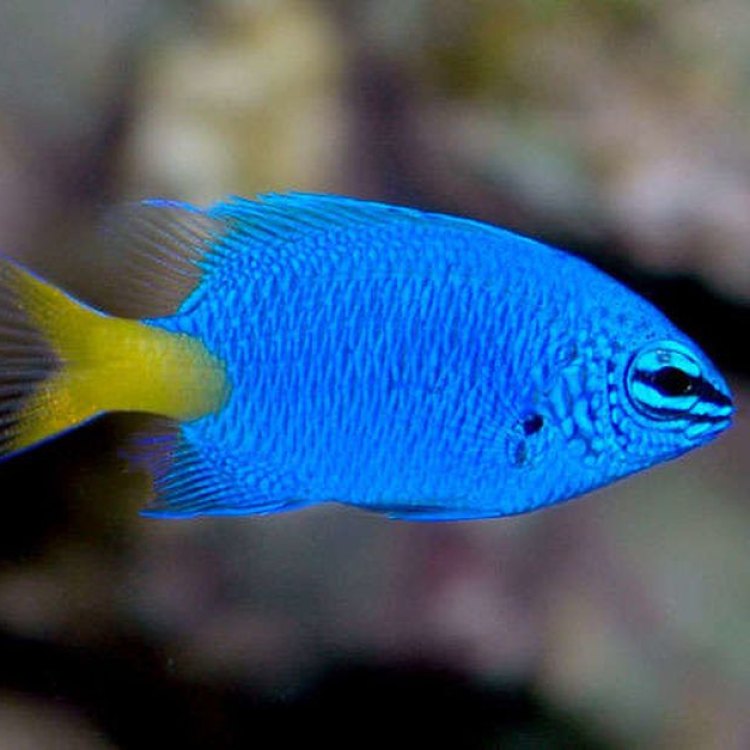
Damselfish
- Adult Size: Varies by species
- Average Lifespan: 5 to 10 years
- Reproduction: Sexual
- Reproductive Behavior: Monogamous
- Sound or Call: None
- Migration Pattern: Varies by species
- Social Groups: Schools
- Behavior: Territorial and aggressive
- Threats: Overfishing, habitat destruction
- Conservation Status: Varies by species
- Impact on Ecosystem: Important reef ecosystem role
- Human Use: Aquarium trade
- Distinctive Features: Continuous dorsal fin
- Interesting Facts: Damselfish are known for their bright colors and are found in a wide variety of species and colors.
- Predator: Predators include larger fish species such as groupers and barracudas.
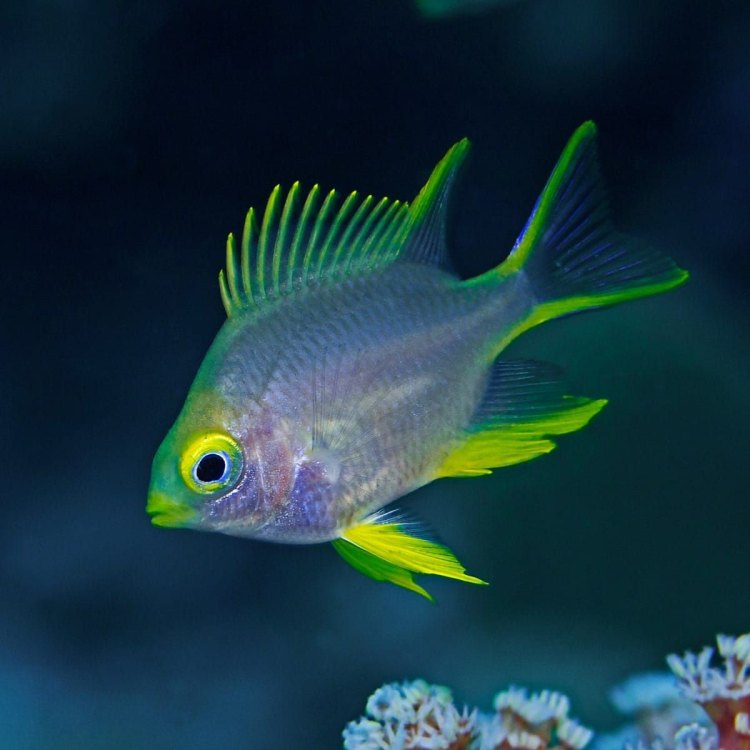
Pomacentridae
The Colorful World of Damselfish: Important Reef Ecosystem Players Facing Threats
The ocean is a vast and mysterious place, home to an array of amazing creatures and ecosystems. One of the most fascinating creatures found in the ocean is the damselfish. These tiny fish may seem insignificant, but they play a crucial role in the delicate balance of the ocean's reef ecosystems.Damselfish are a diverse group of fish, with over 300 species found in various marine habitats around the world PeaceOfAnimals.Com. They are typically small in size, ranging from 1 inch to 6 inches in length, and are known for their vibrant colors and unique behaviors.
Let's dive deeper into the world of damselfish, exploring their characteristics, behaviors, and the threats they face.
Adult Size and Average Lifespan
One of the most intriguing aspects of damselfish is their wide range of sizes. The size of an adult damselfish varies greatly depending on the species and can range from less than an inch to 6 inches in length. This makes them a great addition to aquariums, as there is a damselfish suitable for any sized tank.In terms of lifespan, damselfish can live for an average of 5 to 10 years in their natural habitat. However, in captivity, they have been known to live for up to 20 years with proper care and nutrition. This makes them a long-term commitment for those looking to keep them as pets in their aquariums.
Reproduction and Reproductive Behavior
Like most fish, damselfish reproduce sexually, with the male fertilizing the female's eggs externally De Kays Brown Snake. Interestingly, damselfish are known to be monogamous, meaning they mate with only one partner for life. This behavior is not seen in many other fish species, making it a distinctive characteristic of damselfish.During the mating process, the male and female damselfish swim together in a spiral pattern, with the female releasing her eggs and the male fertilizing them. The fertilized eggs are then left to float in the water until they hatch, which can take anywhere from 1 to 5 days, depending on the water temperature.
Sound or Call, Migration Pattern, and Social Groups
While many marine creatures use sound or calls to communicate, damselfish do not. They rely on visual signals and behavior to communicate with one another and their surrounding environment.The migration pattern of damselfish varies by species. Some species are known to be stationary, living in the same area for their entire life. However, other species are known to migrate short distances, typically during certain seasonal changes.
In terms of social groups, damselfish are typically found in schools, swimming together in large groups. However, some species are known to be solitary, only coming together during breeding season.
Territorial and Aggressive Behavior
Despite their small size, damselfish are known to be territorial and aggressive in defending their space. They are not afraid to confront larger fish and even divers who enter their territory. This behavior is due to their protective nature, as they defend their territory for feeding and breeding purposes.In aquariums, it is not recommended to keep multiple species of damselfish together, as they may exhibit aggressive behavior towards one another. It is best to keep them with similar species to avoid any conflicts.
Threats and Conservation Status
Sadly, damselfish are facing numerous threats in their natural habitat. Overfishing is a major concern, as these fish are often caught in large numbers for the aquarium trade. This has led to a decline in these fish populations, especially in popular diving areas where they are heavily targeted.Habitat destruction, such as pollution and coral bleaching, also poses a significant threat to the survival of damselfish. As they are an important part of the reef ecosystem, their decline could have a detrimental impact on other marine life.
The conservation status of damselfish varies by species, with some species being listed as least concern while others are listed as vulnerable or endangered. It is crucial to protect and preserve their natural habitats to ensure the survival of these colorful fish.
Impact on Ecosystem and Human Use
Although small in size, damselfish play an important role in the health and balance of the reef ecosystem. They are herbivores, feeding on algae and microorganisms, which helps keep the reef clean and thriving. Their aggressive behavior also keeps other fish from overgrazing on the reef, ensuring the survival of the coral and other marine life.In terms of human use, damselfish are popular fish in the aquarium trade due to their vibrant colors and relatively easy maintenance. However, it is essential to ensure that these fish are ethically sourced and not contributing to the decline of wild populations.
Distinctive Features and Interesting Facts
Damselfish are known for their bright and vibrant colors, making them a delight to see in the open ocean or in aquariums. They come in a variety of species, each with their distinctive color patterns and markings. You can find everything from bright blues, yellows, purples, and even rainbow-colored damselfish.Another interesting fact about damselfish is that they are known to go through a "color change" during their reproductive cycle. The males will often become darker and more vibrant during breeding season to attract a mate.
Predators
Despite their territorial and aggressive behavior, damselfish are not at the top of the food chain. They have numerous predators, including larger fish species such as groupers and barracudas. Due to their small size, they are also vulnerable to predators such as eels, octopus, and some species of birds.In Conclusion
Damselfish may seem like just another colorful fish in the sea, but they are unique and essential players in the ocean's reef ecosystems. From their monogamous behavior to their territorial and aggressive nature, these fish have many intriguing characteristics. However, they also face significant threats that require our attention and conservation efforts to ensure their survival in the wild. So next time you see a damselfish darting around a coral reef, take a moment to appreciate the important role they play in this colorful underwater world.
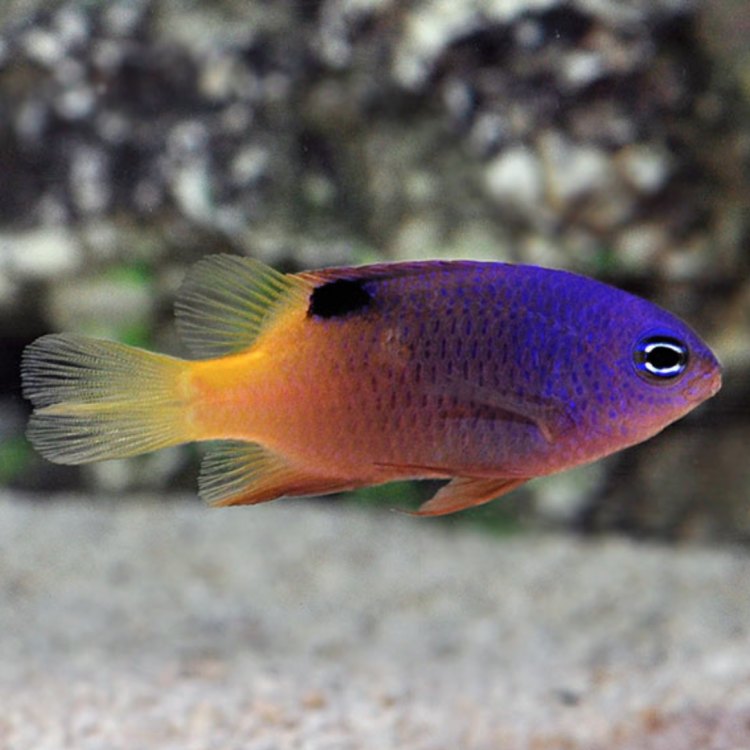
The Fascinating World of Damselfish
Disclaimer: The content provided is for informational purposes only. We cannot guarantee the accuracy of the information on this page 100%. All information provided here may change without prior notice.





